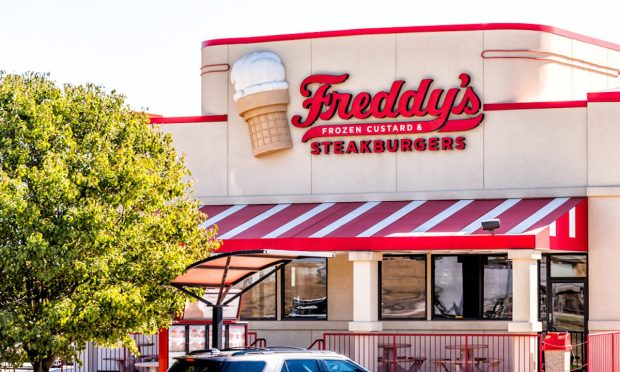F6: Four Factors Forming Fast-Casual’s Future with Freddy’s

Fast-casual is the quickest-growing category in the restaurant sector, with studies finding that the segment is currently growing about 8% each year, compared to the quick-service restaurant (QSR) and full-service restaurant (FSR) markets, which are each growing around 5% annually.
Freddy’s Frozen Custard & Steakburgers, one of the fast-casual restaurants benefiting from the category’s rapid growth, entered its 34th state last month. The Wichita, Kansas-based chain operates more than 400 locations throughout the United States. Freddy’s President and CEO Chris Dull recently spoke with PYMNTS about the factors driving the growth of the chain and the category on the whole.
Flexibility
One of fast-casual’s main advantages is that it can offer much of the flexibility of QSRs, meeting consumers where they are across channels, while also offering a higher quality of food.
“Consumers are cooking less and are seeking speed and flexibility when it comes to mealtime,” Dull said. “This has lent itself to the growth of fast-casuals, because we can fit their ever-changing schedules.”
Chains that offer as many purchasing channels as possible — drive-thru, mobile ordering, desktop ordering, pickup, curbside, delivery and in-restaurant ordering — have the advantage with today’s omnichannel consumer.
Data Analytics
One-size-fits-all no longer fits much of anyone — today’s restaurant customer expects personalization.
“Improvements in data capture will allow concepts to understand consumer behaviors better and result in more personalized marketing efforts,” said Dull. “Our world has become increasingly digital, and the fast-casual space is no different, so we expect to see even more growth and creativity in this space.”
Restaurant brands are increasingly taking advantage of their mobile and web platforms to understand consumers’ behaviors. Understanding users’ previous purchases and getting hyper-specific with segmentation is allowing brands to create a more personal relationship with their customers, driving sales and building loyalty.
Read more: Beverage Chain Tastea Uses Digital Segmentation to Ease Growing Pains
Automation
In today’s labor market, fast-casual concepts that can make the most out of the staff they have will have the advantage in meeting demand and maintaining quality.
“I see labor optimization through better use of technology and automation as growing trends in the fast-casual space,” said Dull. “I believe fast-casual will continue to have strong vertical growth in the dining segment, and the adoption of new technology will be an even greater focus.”
Certainly, automation has come a long way this year alone. Robotic solutions are emerging to handle various steps of the cooking process, and fully automated restaurants are on their way, helped by the rise of digital ordering.
See also: SJW Robotics CEO: Delivery Boom Paves the Way for Robotic Restaurants
Drive-Thru
Fast-casuals can take the tip from QSRs, taking advantage of the efficiency of the drive-thru, as well as the high demand for the channel, to drive sales. Across the industry, restaurants are creating new drive-thru concepts, investing in optimizing the drive-thrus they already have, and finding innovative ways to integrate mobile ordering and other digital technologies into the experience.
You may also like: Faster Drive-Thrus Are Eating Dining Rooms’ Lunch and Reshaping the Future of Restaurants
PYMNTS’ research featured in the May edition of the Order to Eat report, created in collaboration with Paytronix, found that more than one in four already vaccinated restaurant customers would be encouraged to spend more on their food orders if the restaurant offered drive-thru pickup.
Related news: The Key Features That Helped Clean Juice Keep Sales Flowing
“We have put energy into optimizing our drive-thru technologies because we know it’s an area that has helped bolster our growth and has led many of our locations to thrive, even during the pandemic,” Dull said, adding that recent adjustments have shortened the chain’s average check time by 15 seconds. “This has the potential to increase the number of guests we can serve during peak times by 30%. We have been tracking our results very closely, and it definitely will impact our restaurant design decisions in the future.”
